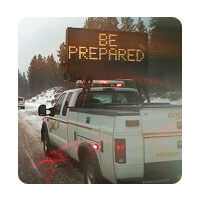 Falling snow can certainly be picturesque, but as we should remind ourselves it can also wreak havoc on the roads. While no one typically enjoys driving in snowy or slippery conditions, there are steps you can take to help improve your safety and the safety of others on the roadways.
Falling snow can certainly be picturesque, but as we should remind ourselves it can also wreak havoc on the roads. While no one typically enjoys driving in snowy or slippery conditions, there are steps you can take to help improve your safety and the safety of others on the roadways.
Here are a few general reminders that can help you stay safe when driving in adverse winter conditions:
- Make sure your car is prepared for cold temperatures and wintery conditions like snow and ice. Keep your equipment properly maintained and include a winter survival kit in your vehicle: an ice scraper, snow shovel and sand/salt. Jumper cables are also a good idea since batteries are prone to failure during cold weather.
- Take those few moments to clear snow and ice off your car before you drive – including windows, mirrors, lights, reflectors, hood, roof and trunk.
- Drive with your headlights on, and be sure to keep them clean to improve visibility not only for yourself, but so others can see your headlights as well.
- Use caution when snow banks limit your view of oncoming traffic.
- Avoid using cruise control in snowy or icy conditions. In adverse conditions, you want as much control of your car as possible.
- Know how to brake on slippery surfaces. Vehicles with anti-lock brakes operate much differently from those that do not have anti-lock brakes. You should consult your vehicle’s owner’s manual for instructions on how to brake properly if your vehicle should start to skid.
- Maintain at least a half tank of gas during the winter season driving. This helps ensure you have a source of heat if you are stuck or stranded.
- If you do venture out or are unexpectedly caught in a snowstorm and encounter problems, stay in your car and wait for help. But if you’re off the road you will want to make certain your exhaust pipe(s) are clear of snow and obstruction. There is a severe danger of carbon monoxide poisoning if snow blocks the pipe and enables the deadly gas to build up in your car. If you are unable to fully clear the obstruction open your window slightly to help prevent the buildup carbon monoxide.
- Keep your windshield washer reservoir as full as possible, and make sure your car has wiper blades that are in good condition.
- Remember that speed limits are meant for dry roads, not roads covered in snow and ice. You should reduce your speed and increase your following distance as road conditions and visibility worsen.
- Be cautious on bridges and overpasses as they are commonly the first areas to become icy.
- Avoid passing snow plows and sand trucks. The drivers can have limited visibility, and the road in front of them could be worse than the road behind.
- Monitor road and weather conditions by checking local news stations or Internet traffic and weather sites.
- If you must travel during a snowstorm or in blizzard conditions, be sure to let a relative, friend or coworker know where you are headed and your expected arrival time. Avoid the temptation to check or be on your phone while driving as all of your attention should be on arriving safely.